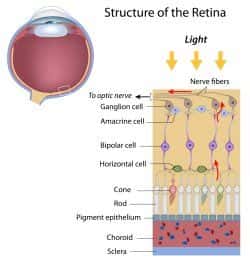If you suffer from Bell's palsy, a paralysis of one side of the face caused by nerve inflammation, you may lose control over your eyelids. This eyelid paralysis can create problems for the sensitive cornea that protects the eye's lens and helps focus light waves into clear images. Fortunately, an experienced
Read more
Retinal disorders are conditions that affect the layer of tissue at the back of the eye, known as the retina. This important part of the eye responds to light and passes on images to the brain. All retinal disorders affect your vision in some way, but some can also lead to blindness.
Macular degeneration. Also known as age-related macular degeneration (AMD), this condition affects the center part of the retina, the macula. This area is needed for the sharp, central vision that is used during everyday activities such as driving, reading or working with tools. This condition is a leading cause of vision loss in people over the age of 60 years old. Treatment can slow the loss of vision, but it will not restore vision that has already been lost.
Diabetic eye disease. The high blood sugar (glucose) levels that occur with diabetes can also affect vision. One type of diabetic eye disease is diabetic retinopathy, which affects the blood vessels in the retina. This can lead to blurry or double vision, blank spots in the vision and pain in one or both eyes. Diabetics may also be at higher risk of developing other eye conditions, such as cataracts and glaucoma.
Retinal detachment. This medical emergency happens when the retina pulls or lifts off of its normal position. It can cause symptoms such as floaters in the field of vision, light flashes and the feeling of a “curtain” in the way of your vision. If not treated right away, a retinal detachment can lead to permanent blindness in that eye.
Retinoblastoma. This cancer of the retina is generally uncommon; although, it is the most common type of eye cancer in children. The cancer starts in the cells of the retina, but can spread to other parts of the body (metastasize).
Macular pucker. Scar tissue on the macula can make the central vision become blurry and distorted. Although the symptoms are similar, macular pucker is not the same as age-related macular degeneration. The symptoms of a macular pucker are usually mild and do not require treatment. Sometimes, the scar tissue can fall off the retina on its own, and the vision will return to normal.
Macular hole. This condition is caused by a small break in the macula, which leads to blurriness and distortion in the central vision. Related to aging, this condition usually happens in people over the age of 60. Some macular holes close up on their own while others require surgery to help improve vision.
Floaters. These are specks, or “cobwebs,” that appear in the field of vision. Unlike scratches on the cornea, which follow your eye movements, floaters can drift even when the eyes are not moving. Most people have some floaters and have no problem with their vision. A sudden increase in the number of floaters, though, can indicate a more serious eye problem such as retinal detachment.
If you notice a change in your vision or simply have not undergone a routine eye ex
-
Bell's PalsyCategory: Common Eye Conditions, Eye Lids
-
Ocular RosaceaCategory: Common Eye Conditions, Injury & Irritation
Ocular rosacea, an inflammation of the eye and/or eyelid, occurs in conjunction with rosacea of the skin. A chronic inflammatory condition, rosacea primarily affects the face, cheeks, forehead, and chest area. When rosacea affects the eyes and/or eyelids, the condition is known as ocular rosacea. Ocular
Read more -
Detached RetinaCategory: Common Eye Conditions, Injury & Irritation
Seeing a spot or a flash of light in your field of vision is more than an inconvenience. It could be the first signs of a detached retina. A retina becomes detached when separated from underlying layers of support tissue. Detached retinas will lead to a permanent loss of vision if they are not quickly
Read more -
Corneal UlcerCategory: Common Eye Conditions, Injury & Irritation
The cornea is present as a clear tissue that is located at the front of the eye. A corneal ulcer occurs when there is a sore in the layer of the cornea. Symptoms of this include redness, drainage, visual disturbances, sensitivity to light, itching and discomfort. Causes and Effects of Corneal Ulcers The
Read more -
ConjunctivitisCategory: Common Eye Conditions, Injury & Irritation
Conjunctivitis, also known as pink eye, is a common eye problem that can afflict children and adults alike. It is highly contagious and spreads quickly in environments like classrooms or offices filled with multiple people in close proximity to one another. The good news is that conjunctivitis is easily
Read more -
Acanthamoeba KeratitisCategory: Common Eye Conditions, Injury & Irritation
Acanthamoeba keratitis is a relatively rare type of eye infection, but it can become quite serious. If left untreated, Acanthamoeba eventually leads to vision loss, requiring a corneal transplant to restore sight. Understanding how to prevent this infection is key. What Is Acanthamoeba Keratitis? Acanthamoeba
Read more -
Low VisionCategory: Common Eye Conditions, Vision Impairment
Most people classified as blind still retain some ability to see. They often have significantly impaired vision but can discern light, shapes, or other figures. Low vision refers to a class of visual impairment that cannot be corrected by glasses or contact lenses. A number of conditions may cause low
Read more -
Color BlindnessCategory: Common Eye Conditions, Vision Impairment
Color blindness, also known as color vision deficiency, occurs when an individual cannot distinguish between certain colors like red and green or, less commonly, blue and yellow. Cause of Color Blindness Light-sensitive tissue, the retina, lines the back of the eye and consists of two types of light
Read more -
NystagmusCategory: Common Eye Conditions, Cognitive and Acquired
Nystagmus is a vision condition characterized by repetitive, uncontrolled eye movements. These involuntary eye movements may be side-to-side, up and down, or in a circular pattern, which hinders the eyes’ ability to focus on a steady object. Individuals with nystagmus may hold their heads in unusual
Read more -
Macular HoleCategory: Common Eye Conditions, Cognitive and Acquired
The condition known as a macular hole refers to a tiny break in the macula that results in blurry or distorted vision. To fully understand the condition, one must understand eye anatomy. The macula is a spot located in the center of the retina (the back portion of the eye). Located where light comes
Read more -
PresbyopiaCategory: Common Eye Conditions, Age-Related
As we age, our eyes—like the rest of our bodies—begin to lose flexibility and strength. When this happens to the lens of the eye and its surrounding muscles, your lens will become stiff. This makes it harder to see close objects clearly because the eyes can't focus properly. It's a natural part of
Read more -
What Is a Chalazion?Category: Newsletters
Could that bump on your eyelid be caused by a chalazion?
Read more -
Reasons Why Your Eyelid is SwollenCategory: Newsletters
Are you wondering why you have a swollen eyelid?
Read more -
Different Types of Contact LensesCategory: Newsletters
Do you know which type of contact lens is right for you?
Read more -
How Diet Affects VisionCategory: Newsletters
Want to protect your eyesight? Try making a few changes to your diet.
Read more -
What to Do When You Get Something in Your EyeCategory: Newsletters
Do you have something stuck in your eye? Try a few of these helpful tips.
Read more

